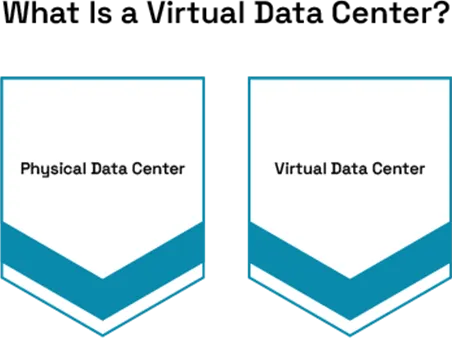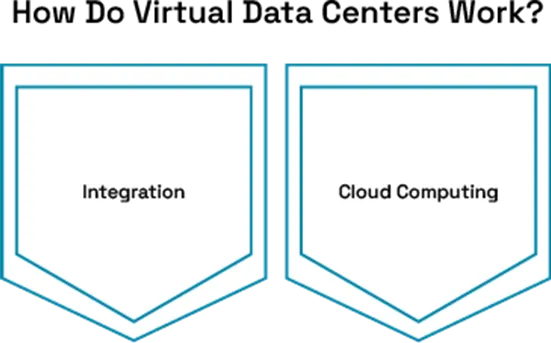That is why, with advanced information technology being applied in the market, the SMEs have the problem of dealing with it, as they have to keep on changing their methods, yet they have thin margins. One such innovation, a particularly revolutionary tool in this regard, is the Virtual Data Center (VDC). This cloud-based solution is an expansion of the core business of physical data centers, but has apparent advantages. VDCs are the way to give small businesses access to enterprise-class IT underneath their umbrella without having to incur the heavy expense or a level of IT specialization that they may not be able to support.
This paper seeks to unravel the real meaning, significance, working, benefits, and issues that SMEs face regarding virtual data centers.
What Is a Virtual Data Center?
A virtual data center is an imitation of the physical data center, but is hosted in a cloud platform. It provides computation infrastructure or similar services involving processing, storage, memory, and networks through virtualization. In other words, it provides the same capabilities as physical IT infrastructure while eliminating the necessity for the business to buy and manage the equipment itself.
The VDCs can be obtained from leading cloud solutions providers such as Microsoft Azure, Amazon Web Services, and Google Cloud. It also makes it possible for the SMEs to configure, deploy, and manage their virtual infrastructures through interfaces. From website hosting to application running and even data storage, VDCs create a central, more adaptable platform for a business’s operations.

Why Should SMEs Consider Virtual Data Centers?
When it comes to managing an organization’s own IT infrastructure for SMEs, the scenario often proves to be quite expensive as well as time-consuming. The conventional data center deploys capital in hardware, physical infrastructure, service, and human resources in terms of IT staff. These are removed by VDCs to allow the SMEs to concentrate on innovation and expansion of their businesses rather than the infrastructure.
Also, the VDC solves the problems by proposing its use by businesses that are in a growing phase or will have an unpredictable amount of work at a certain period. They entail flexibility since it means that the resources can be easily adjusted depending on the amount of traffic, whether high or low. This flexibility is very important for SMEs that are competing in today’s uncertain and competitive environment or those that have expanding digital services portfolios.
How Do Virtual Data Centers Work?
Virtual data centers are implemented by virtualization and cloud computing technologies. With virtualization software, one can host several VMs on a single physical host without interference from one over the other. These virtual machines can be allocated a certain degree of processing power, disk storage, and amount of memory as needed for a certain business.
SMEs can organize their infrastructure, view their usage, and provision applications through a cloud provider’s dashboard or control panel. These interfaces are also easy to use most of the time, and the non-technical users hardly require a staking point to get familiar with this interface. Therefore, integration with the existing software, better security tools, and automation make it possible for the SMEs to eliminate complexity through reducing manual involvement.

Benefits of Virtual Data Centers for SMEs
Another advantage of virtual data centers is the aspect of costs, since the center is not physically constructed. SMEs in this case do not require costly physical servers, power, cooling, and IT personnel. They only spend on the usage they make of the facilities and services, thereby transforming capital expenses (CapEx) into operational expenses (OpEx), which is more convenient for planning and cost control.
Also, the VDCs provide other features necessary for improving enterprise performance, including high availability, disaster recovery, and global setup. It is for this reason that providers can afford to guarantee continuous uptime, security, and data redundancy. To the SMEs, this means that they are in a position to provide quality services to their customers, the same as the large-scale corporations, while using the same infrastructure, hence reducing the competitive edge.
Challenges and Considerations
However, some pitfalls should be considered by SMEs while adopting the concept of virtual data centers. Security is always an issue since customers’ information is central to a telecom business. Despite sets of measures, security in many cloud computing services depends on the client’s selection, installation, and controls for system setup, who has access to the applications, and other compliance issues.
Another impediment is the lock-in strategy associated with most of the services or product vendors in the marketplace today. That is why integrating with a particular cloud platform can be a difficult process, as it may take time, require advanced technical work, and cost a lot of money to switch to another platform. Small and medium businesses must always be wary of the costs involved; costs are based on the usage of cloud services; hence, if not properly supervised, businesses are likely to land in a financial mess. It is still important to understand their needs in terms of resources, as well as to employ proper practices to work on these problems.








